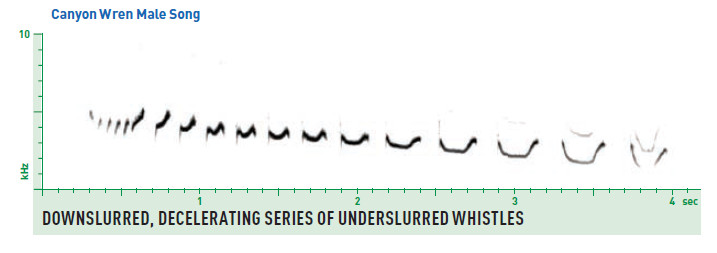Changes in speed and pitch of whole songs
(Peterson Field Guide to Bird Sounds, interactive version of pp. 10-11)
Some bird sounds consist of series that change in speed. If the elements in a series are more closely spaced on the spectrogram as you move from left to right, then they are growing more closely spaced in time, which means that the series accelerates. If the elements grow farther apart, the series decelerates.
 Phrases, series, warbles, and trills can also change in pitch. For example, a warble might sound upslurred if it shows an overall trend toward higher notes. Similarly, a series might fall in pitch if each note starts slightly lower than the last, regardless of the pitch pattern of the individual notes.
Phrases, series, warbles, and trills can also change in pitch. For example, a warble might sound upslurred if it shows an overall trend toward higher notes. Similarly, a series might fall in pitch if each note starts slightly lower than the last, regardless of the pitch pattern of the individual notes.
 The song of the Canyon Wren is a downslurred, decelerating series. Notice that the individual notes in this particular song are not downslurred, however; most of them are underslurred. As they progress from left to right, they slow down. They also become fainter on the spectrogram, meaning they are not as loud.
The song of the Canyon Wren is a downslurred, decelerating series. Notice that the individual notes in this particular song are not downslurred, however; most of them are underslurred. As they progress from left to right, they slow down. They also become fainter on the spectrogram, meaning they are not as loud.
These songs both accelerate. The Field Sparrow’s song begins as a series and speeds up into a trill; in this example the series is downslurred. The Horned Lark’s song begins as a phrase and becomes a warble, rising in pitch at the end.
Complex series
Sometimes the repeated elements in a series themselves consist of multiple notes. A couplet series sounds like a 2-syllable word repeated, such as “peter peter peter”; a triplet series sounds like a 3-syllable word repeated, such as “teakettle teakettle teakettle.” Series of 1-syllabled notes can be called simple series.
Common Yellowthroat Song:
(Next: pp. 12-13: Pauses)




